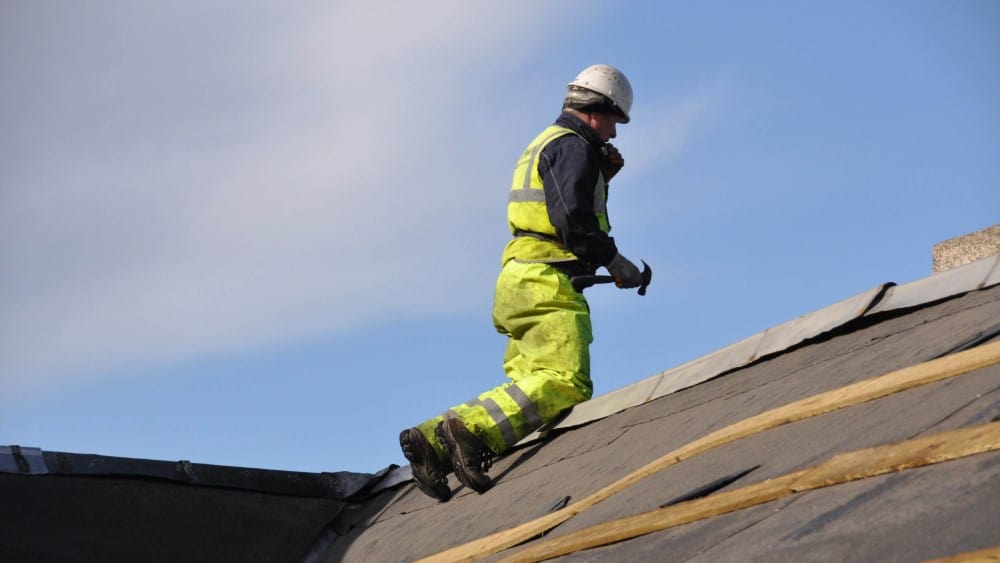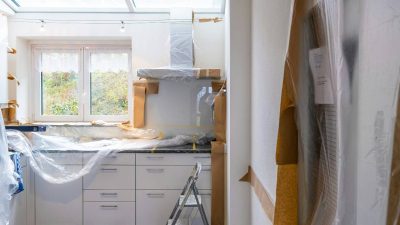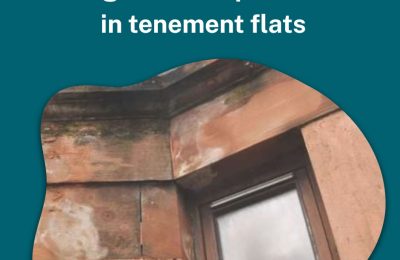Maintaining a tenement building’s roof is crucial for preserving its structural integrity and ensuring residents stay warm and dry. This article provides insights into various aspects of tenement roof repairs, including roof types, best practices, accessing the roof, navigating building contracts, and prioritising health and safety.
Tenement roof types and materials
Roofing materials on tenement buildings vary and may include slate, tiles, lead, or zinc, depending on when the building was constructed.
Slate roofs were common until Scottish slate quarries closed in the 1960s, but quality second-hand slates are still available for repairs. Re-slating, although costly, offers durability, and may be required for listed buildings or in conservation areas.
Tiled roofs gained popularity after the decline of slate and can be found on buildings of all ages. Older concrete tiled roofs from the 1980s may require re-tiling as they near the end of their lifespan.
Flat roofs, also found on buildings of all ages, are constructed from materials like lead, zinc, bitumen felt, and asphalt felt. They should be laid with a gentle slope to allow rainwater drainage.
Checking the roof
Regular roof maintenance is essential. Conducting annual inspections is highly recommended, so that any problems can be dealt with swiftly, before they worsen and cause further damage. Late autumn is a good time to carry out these checks as they can be combined with leaf and debris removal from hidden valleys and gutters.
Visual inspection, either from inside the loft or high vantage points nearby, is the simplest and cheapest way to check a building’s roof. When this is not feasible, other methods include:
- Drone inspections
- Pole and mast photography
- Rope access
- Tower access
- Powered access, such as cherry pickers
The choice of inspection method depends on factors like the building’s structure and available budget. Buildings equipped with roof anchors may favour rope access, while areas unsuitable for drone flights might opt for pole and mast photography.
Organising roof repairs
Once an inspection has been carried out and the repair work identified, it’s necessary to organise the repair.
Roof repairs are usually a common responsibility shared amongst all owners in a tenement building. But, as always, check the titles to confirm who is responsible and the share of repair costs. In cases where the titles are silent on roof repairs, the default rules in the Tenements (Scotland) Act 2004 should be followed. Under the Act, the roof is a common responsibility, so all owners must share the repair costs.
When carrying out common repairs, following proper procedures is crucial. This includes informing all owners of the required work beforehand and collaboratively reaching decisions, such as obtaining quotes and selecting a trades firm.
However, different steps should be taken in emergency situations. As always, check your titles to see if they address emergency repairs; if not, any owner can instruct urgent work and recover costs from the other owners. For example, if roof damage is causing leaks into a flat or poses health and safety risks, immediate action is warranted. When carrying out an emergency repair, documentation at each stage is essential, along with confirmation from a professional confirming the emergency nature of the repair. Other owners must then be informed of the repair, including details of why the emergency action was taken, to recover costs.
All owners have a duty to maintain the parts of the tenement building that provide support and shelter, which includes the roof. This is a powerful legal protection for buildings and if owners are reluctant to pay, then there are enforcement options available through the local council and by taking legal action.
Building contracts
Prior to accepting a quote and starting the works, even in the case of an emergency repair, it’s essential to have written agreement in the form of a building contract with the trades firm. In Scotland, most building contracts adhere to standards outlined by the Scottish Building Contracts Committee (SBCC). For larger works, such as a major roof repair or replacement, purchasing an SBCC formal contract for reference is worthwhile.
A good building contract should contain the following key elements:
- Scope of the work: a detailed description of the intended work, including any building warrants and permissions.
- On-site arrangements: permitted working hours, builder’s facility usage, insurance provisions, and work conditions.
- Timing: start and finish dates, conditions for extensions, and the duration allocated for addressing ‘snagging’ issues (typically three months as per SBCC contracts).
- Costs: the agreed price, procedures for handling price variations, instalment schedules, retention terms, and the duration for which retention funds will be held.
- Disputes and guarantees: procedures for handling disputes, guarantees in place for addressing faults, termination clauses, procedures for addressing builder’s default or incompetence, cancellation terms, insolvency, or client’s failure to pay.
Typically, an individual owner or property manager signs the building contract. The individual who signs the contract assumes responsibility for all payments and cost recovery from other owners. Thus, it’s advisable to obtain payments in advance wherever possible.
For major roof repairs, seeking professional help is vital. An architect or surveyor should be consulted for these sorts of repairs and may be employed to manage the building contract and oversee the works.
Health and safety when carrying out repairs
Health and safety considerations are important for any repair work, but especially for roof repairs due to the increased height and risk of falling. If the building has a factor, they will be responsible for arranging health and safety procedures. Likewise, if an architect or surveyor has been employed to manage the building contract, they will take responsibility. But, if an owner chooses to manage the contract themselves, they will need to ensure the contractor has proper health and safety procedures in place.
This can be done by:
- Checking the Health and Safety Executive Public Register of Enforcement Notices
- Requesting a copy of the firm’s health and safety policy (for those with more than five employees)
- Asking to see any required licenses
- Asking about the risk assessment carried out by the contractor
For further information on repairing tenement roofs, check out this article.











